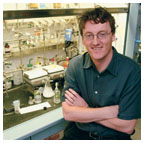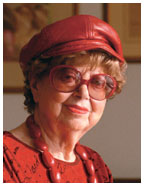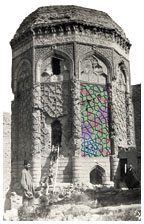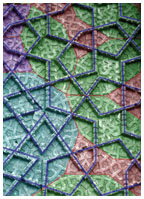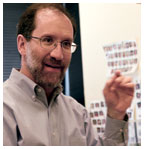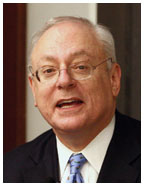
|
April 18, 2007: Notebook
Research offers quicker path to drug development
Retired faculty enjoy their ‘permanent sabbatical’
Events mark 60 years of Jewish life at Princeton
Attacking the underpinnings of Alzheimer’s disease
Chemistry professor David MacMillan in his lab in Frick. (Frank Wojciechowski) |
Research offers quicker path to drug development
Professor David MacMillan and his research team have discovered a new approach in chemistry that could speed the development of new drugs while paving the way for previously unknown chemical reactions.
The new method of assembling organic molecules without using toxic catalysts was reported in a paper in the March 30 issue of the journal Science. MacMillan, the A. Barton Hepburn Professor of Organic Chemistry, said the discovery offers both industrial applications and research benefits in fields like biology and physics.
“We have accomplished a new way of activating molecules catalytically,” he said. “This has opened up the door to many chemical reactions never thought possible before.”
The work is a “creative breakthrough” that should “streamline the synthesis of compounds that are relevant to human health,” said John Schwab, a program director at the National Institute of General Medical Sciences, which helped fund the research.
Since 2000, MacMillan has found in his research a new family of organic catalysts — substances that allow chemical reactions to happen more readily without being changed themselves. In the pharmaceutical industry, catalysts often are required to produce large quantities of a drug molecule and to optimize benefits while minimizing side effects. Metal-based catalysts can be costly and difficult to work with, MacMillan said, while organic catalysts are environmentally friendly and less expensive.
In addition, many drug molecules produced by pharmaceutical companies can exist in two forms — known as enantiomers — that cannot be distinguished by most lab tests, yet can have dramatically different effects on the human body, including negative effects. The organic catalysts discovered by MacMillan’s team of researchers can be used to produce only beneficial enantiomers.
Applying the latest research should mean “faster access to more complex drugs,” MacMillan said. At the same time, he said, the research should benefit “anyone who needs to make molecules to test any hypothesis in science.”
MacMillan, regarded as one of the leading organic chemists of his generation,
came to Princeton from Caltech last June along with 20 of the 21 members
of his research team. He co-wrote the Science paper with graduate
students Teresa Beeson and Anthony Mastraccio, post-doc Jun-Bae Hong,
and visiting research collaborator Kate Ashton. ![]()
By W.R.O.

In retirement, sociologist Suzanne Keller is working on two books; she also took a fiction-writing class and is learning Spanish. (Frank Wojciechowski) |
Retired faculty enjoy their ‘permanent sabbatical’
You might not find Princeton’s professors emeriti on the 13th hole of Springdale Golf Course, but whether they’re writing or lecturing, traveling or publishing, they’re using their free time in retirement to stay as active as ever. Still, many say that there are big differences between full-time academia and retirement — and that’s just fine with them.
“The moment you retire here, you’re out of it,” said John Fleming *63. “And I don’t mind that. There’s a real upside to it.” Fleming, who transferred to emeritus status last spring after more than 40 years in the English department, has continued his work in medieval studies but also is branching out to a book about World War II-era literature related to communism and anti-communism in America.
A recipient of the Phi Beta Kappa Teaching Award, Fleming says he misses being in the classroom regularly, but he still maintains a presence on campus. He can be found most afternoons in his office in Firestone Library, where about 17 emeritus professors have offices. Papers and books spill off the desk, and coffee cups are strewn about the floor. Fleming often has lunch with students in Wilson College, where he is a fellow. Still, he notices some changes, a major one being that he doesn’t read the Prince, for which he used to write a beloved column, “Gladly Lerne, Gladly Teche.”
Fleming said he wishes Princeton had a more consistent policy for keeping its emeritus professors engaged in the University community. “It’s very uneven, for example, as to what offices are available. Many of the departments automatically have an office for retired professors. I was lucky to get this place, but as you can see, it doesn’t have any windows, and I don’t see many colleagues.”
When Civil War historian James McPherson isn’t working on his upcoming book on Abraham Lincoln as commander in chief, he often can be found giving one of a half-dozen battlefield tours that he leads every year at Gettysburg, Antietam, and Fredericksburg. He and his wife recently traveled the Oregon and Lewis and Clark trails and are planning a tour of national parks. Since retiring in 2004 after 42 years of teaching, McPherson says, he has been busier than ever. “Now that people know I’m retired, they ask me to do things that they would not have asked me to do when they knew I was teaching,” he said. “I have found there’s a catch-22 of retirement.”
Sociologist Suzanne Keller said retirement has provided a chance to nurture her creativity. The president of the World Society for Ekistics, an international nongovernmental organization focusing on the interactions between people and the environment, she is working on one book on the nature of leadership and another on how American society is changing as its population ages. Keller sometimes works out of her office in the Prince-ton University Press building on William Street. “It’s a very sweet little office,” she said. “Emphasis on little.”
Keller, the first woman to be granted tenure at Princeton, is one of a small but growing number of professors emeritae. “At the moment there are fewer,” she said, “because we started later.” She recently took a fiction-writing class, enjoys cooking, and is learning Spanish. “I putter more,” she added. “I can read the Times in the beginning of the day instead of the end.”
Irvin Glassman, who retired in 1999 after 49 years of teaching mechanical and aerospace engineering at Princeton, keeps busy filling in what he sees as gaps in his engineering education: “reading, reading, reading.” As a student at Johns Hopkins, he spent all his time in mechanical and aerospace engineering classes. “I had absolutely zero liberal arts courses, believe it or not,” he said. Now he’s making up for lost time. “I’ve collected all the classics over the years, and I swore I was going to read them,” he said. “But I became addicted to mystery stories.” Glassman has also become an avid reader of books about politics. And, he added, “I’m also a crossword-puzzle addict.”
Glassman said he doesn’t miss the administrative aspects of full-time academia. As a full-time professor, “I had lots of graduate students and a big lab that really dominated my time,” he said. “I had to bring in eight hundred thousand, a million dollars a year to support graduate students and all that business. It’s gone now, and I’m sort of glad, in a way.”
Like Fleming, Glassman said the University’s policy toward emeritus professors could be improved. “Yale just got a big endowment where they’re building a special building for their faculty who want to stay active. When you communicate with your colleagues, you make a contribution. “Princeton has none of that. Each of the departments treats their retired faculty in a certain way,” he said.
When people ask Victor Brombert what he’s doing now, he replies, “I’m not retired, I’m on permanent sabbatical.” Since transferring to emeritus status in 1999 after 24 years in the departments of Romance Languages and Literatures and Comparative Literature, he has published his memoirs and started a book in French about the 19th-century author Stendhal. Brombert spends three or four months of the year in Paris, where he was raised; passes the summer months in Italy; and lives the rest of the year in Princeton.
His time, he finds, is more his own. “I like to dream,”
he said. “Writing, walking, dreaming, going to the opera, seeing
friends.” Then he smiled. “Parties ... I like that, too. And
good food. And I like oysters. And I like Champagne.” ![]()
By Laura Fitzpatrick ’08

Events mark 60 years of Jewish life at Princeton
The Center for Jewish Life is marking the 60th anniversary of organized Jewish activity at Princeton amid increased efforts to reach out to Jewish applicants. The number of Jewish students has rebounded since it fell in the 1990s, said Rabbi Julie Roth, the executive director of the CJL, and the organization's top priority is to "expand our ability to provide the highest number of meaningful Jewish experiences that will inspire the next group of Jewish leaders."
Although it is not clear when the first Jewish student enrolled at Princeton, the Princeton Jewish Society was formed in 1942 to "stimulate a consciousness of [students'] unique religious, philosophical, and artistic past:' The CJL dates the start of organized Jewish life to what is believed to be the first University-backed Jewish religious service on campus, held Jan. 13, 1947, with Albert Einstein, among others, attending. Einstein led an informal discussion "on topics of current interest" afterward, according to an article in The Daily Princetonian. A chapter of Hillel, a national organization for Jewish college students, was formed in 1948.
Though Princeton does not collect complete information on students' religious affiliations, The New York Times reported in 1999 that the percentage of Princeton students identifying themselves as Jewish had dropped from a high of 18 percent in the early 1980s to 10 percent. Roth believes the number has risen to at least 12 percent, based on optional student surveys submitted to the Office of Religious Life and the number of students participating in center activities. Still, the percentage of Jewish students at Princeton is believed to lag behind most other Ivy League universities.
Nevertheless, Roth said, Princeton "exhibits an extraordinary support of Jewish life on campus." In addition to maintaining the CJL and its kosher dining hall, Roth said, the University has given the center permission to raise $3 million in endowment funds, and has begun to "think strategically about how to get the word out that it is great to be Jewish at Princeton."
Professor Dan Rubenstein, chairman of the center's board if directors, said that the University has made a "proactive effort to let students know that Princeton is a welcoming place" for Jewish students. Roth and Dean of Admission Janet Rapelye visited two Jewish private schools in New York and New Jersey recently to encourage students to apply to Princeton, and Roth has visited six Jewish schools in California.
"When I was deciding where to attend college, I heard that Princeton's Jewish community was small, but cohesive and very welcoming," said Matthew Kandel '08, president of the CJL's student board. "This turned out to be accurate."
The CJL sponsors a wide range of programs and activities for Orthodox, Conservative, Reform, and unaffiliated Jews.
A luncheon speech March 28 by former Seagram CEO Edgar Bronfman, chairman of the Hillel board of governors, kicked off a series of events marking the CJL's anniversary. On June 1, the Friday of Reunions weekend, the CJL will host a discussion of Jewish life at Princeton featuring Professor Stanley Katz, a former president of the CJL, and Marianne Sanua '82, an associate professor at Florida Atlantic University. Next fall, the CJL will host its first-ever event at the Princeton Club in New York, and in December it will hold a Hanukkah "blast and blowout" on campus. By M.F.B.
(COURTESY OF THE FINE ARTS LIBRARY, HARVARD COLLEGE LIBRARY/ANTOIN SEVRUGUIN, PHOTO ILLUSTRATION BY PETER J. LU ’00; R. HOLOD/ PHOTO ILLUSTRATION BY PETER J. LU) |
Girih patterns, the decorative mazes of stars and polygons found in medieval
Islamic architecture, demonstrate an understanding of complex geometric
concepts, including some not discovered in the West until the 20th century,
according to a recent Science paper by Peter J. Lu ’00, a doctoral
student in physics at Harvard, and Paul Steinhardt, Princeton’s
Albert Einstein Professor in Science, who was Lu’s undergraduate
thesis adviser. The photo illustrations above, from the Gunbad-i Kabud
tomb tower in Maragha, Iran, built in the late 12th century, show two
overlapping patterns: raised-brick lines, outlined in blue, and smaller
decorative lines, created using an elaborate tile pattern of decagons
(blue), hexagons (green), bowties (pink), and rhombi (purple). Lu first
became interested in the tiling patterns while sightseeing during a trip
to Uzbekistan. ![]()

Biomedical screening developed in chemistry professor Michael Hecht’s lab could help in the search for ways to treat Alzheimer’s disease. (Beverly Schaefer) |
Attacking the underpinnings of Alzheimer’s disease
One hundred years have passed since German researcher Alois Alzheimer first presented evidence of the protein deposits in the brain responsible for the neurodegenerative disease that now bears his name. Science marked the centenary last fall with a cover story about the disease’s history, noting that “much has been learned, but major questions remain,” including how to stop amyloid-beta, a piece of protein known as the Alzheimer’s peptide, from collecting in the brain. At Princeton, a new approach developed by chemistry professor Michael Hecht’s lab is taking early steps toward solving that important problem.
The Alzheimer’s peptide, Hecht explains, folds improperly into insoluble pieces that collect and form the harmful plaque associated with Alzheimer’s disease. Hecht and Ph.D. student Woojin Kim created a screening system to find compounds that could encourage the Alzheimer’s peptide to fold properly, thus halting the disease’s progression.
Hecht’s screen uses a protein that links the Alzheimer’s peptide with a green fluorescent protein. When a molecule is introduced to the screening protein, one of two basic reactions occurs: If the molecule is not an Alzheimer’s inhibitor, the Alzheimer’s peptide misfolds and collects before the green fluorescent protein has a chance to fold properly and activate its fluorescence. But if the molecule is an inhibitor, the Alzheimer’s peptide remains soluble and allows the green fluorescent protein to fold and display its indicative glow. Molecules that successfully pass the screen, Hecht says, demonstrate an ability to block aggregation of the Alzheimer’s peptide without inhibiting the folding of other proteins.
Screens like the one developed by Hecht’s lab are described as “high-throughput” because they provide a fast, inexpensive way to sort through hundreds of thousands of compounds and find the few that might be helpful in addressing a certain problem, such as the aggregation of the Alzheimer’s peptide. In the case of Hecht’s screen, there are degrees of success that go beyond the simple question of whether the molecule is an aggregation inhibitor. Researchers are most interested in the molecules that yield a strong green signal.
Identifying helpful compounds is just the first step in the long road of drug development. Researchers have to study the biochemistry of the compound, examine toxicity, and test it in animal models to see if the compound is as useful as it seems at that first green blush. But finding the select candidates for Alzheimer’s therapies is an important starting point.
Biomedical screening is a relatively recent addition to Hecht’s research. For nearly 20 years, he has designed novel synthetic proteins, paying particular attention to how linear sequences of peptides fold into three-dimensional structures. He was using a fluorescent-protein screen in his design work when his graduate students and postdocs encouraged him to adapt the approach to screen for possible therapies for a protein-related disease.
Alzheimer’s was a natural fit because of its link to protein folding
and the significant challenge it presents for public health. The disease
afflicts nearly one in eight Americans age 65 or over, according to the
Alzheimer’s Association. “[Existing drugs] are dealing with
the cognitive issues, but they’re not dealing with what’s
causing the cognitive problem,” Hecht says. “There’s
a real motivation to try to develop some sort of therapy that is going
to have an effect on the molecular underpinnings.” ![]()
By B.T.

Alvin Felzenberg
*78 |
“Does anyone seriously believe that Benjamin Harrison was a better president than Ronald Reagan? Or that Reagan was so dangerous to the country as to merit a grade lower than James Madison [1771], whose fate it was to preside over the burning of the White House and the Capitol at the hands of the enemy?”
Alvin Felzenberg *78, visiting lecturer in politics at Princeton, discussing
surveys that have ranked U.S. presidents during a talk on “Assessing
Presidential Legacies” March 29 in Robertson Hall. Felzenberg is
writing a book on how to judge presidents.
![]()

Audio files of almost 800 public events and lectures at the University are available without charge from a new PODCAST WEB SITE. The lectures can be downloaded as MP3 files at www.princeton.edu/WebMedia/podcasts/. The collection of audio files, which date back to 1998, can be accessed by computer users with iTunes or another digital media player. Serge Goldstein, director of academic services in the Office of Information Technology, said that the archives include artists, performers, and scholars, including Princeton faculty. An estimated 100 new campus lectures will be added each year.
KATE AND ROBERT H. NIEHAUS ’77 have endowed a research and teaching center within the Woodrow Wilson School that focuses on globalization. The center, created in 2004 and renamed the Niehaus Center for Globalization and Governance, will host conferences and conduct research with other institutions on topics ranging from international trade and multilateralism to security and nationalism.
The endowment also will provide for expansion of a 10-year-old program
to hold global policy task forces abroad and will support the creation
of a postdoctoral fellowship program to study the political economies
of the world’s regions, focusing on the Mideast. Robert Niehaus
is a managing director of Greenhill & Co. and is the founder, chairman,
and senior member of Greenhill Capital Partners LLC. ![]()

HAROLD POWERS *59, the Scheide Professor of Music History
emeritus, died of liver cancer March 15 in Santa Monica, Calif. He was
78. His scholarly interests took in musicology, ethno-musicology, music
theory, and the relationship of music to language. A member of the faculty
from 1973 to 2001, Powers was well known for his undergraduate courses,
graduate seminars, and scholarship on Italian opera. ![]()

